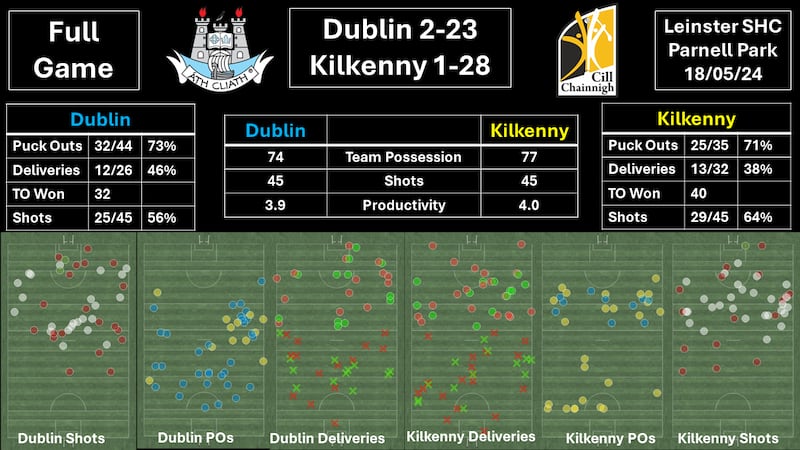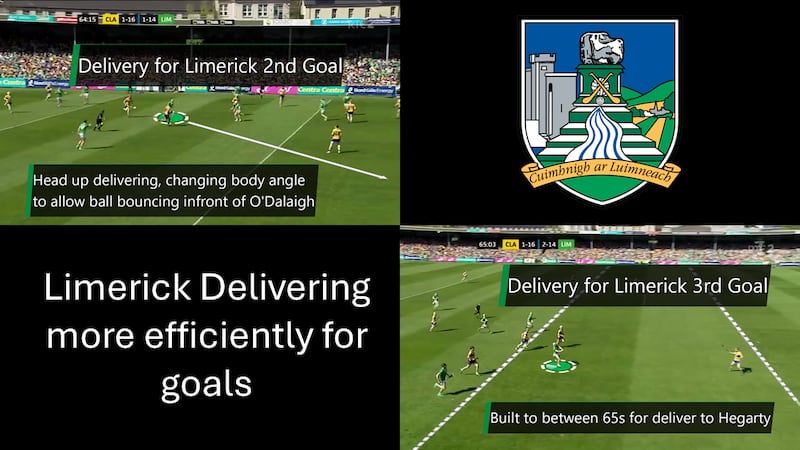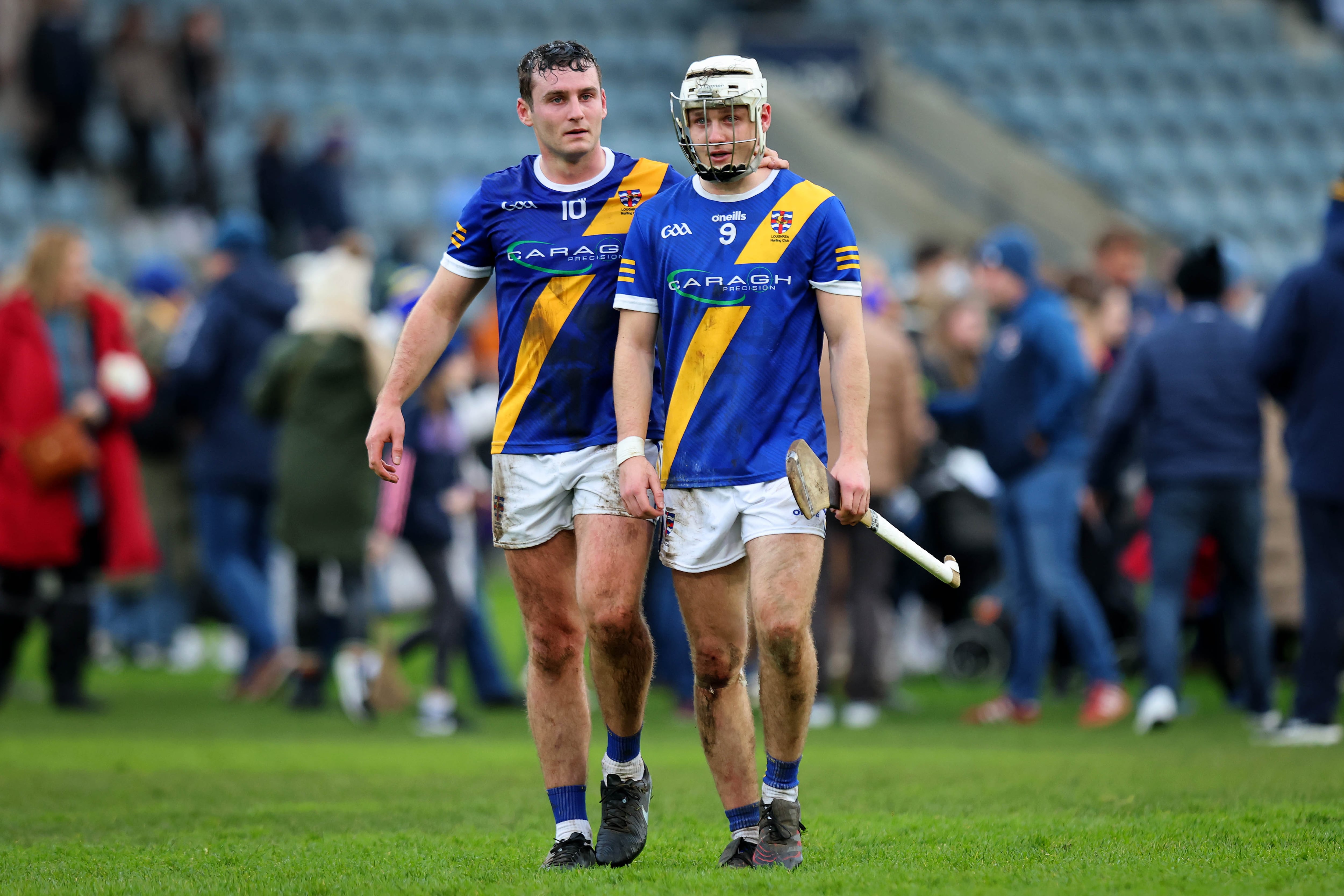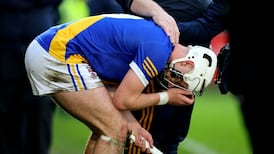Dublin and Clare in recent years have both suffered at the hands of Kilkenny and Limerick respectively, and both have been waiting a long time for provincial silverware – Dublin haven’t won the province since 2013, while Clare have been waiting since 1998. However, there is plenty to suggest from the two close round-robin games between the same pairings that we could see two new provincial winners this weekend.
Leinster final
Dublin appear to have the tools to challenge Kilkenny. In the meeting in Parnell Park, Dublin presented several problems to Kilkenny. In the opening half of the game, Dublin’s main marksman Dónal Burke was able to reel off three points from his dropped-off centre forward position by the 16th minute. This forced Paddy Deegan to pay closer attention to the Na Fianna man and this then immediately left large gaps in the Kilkenny defence.
The Hayes brothers were nearly able to create a goal from Donal Burke winning a puckout in the 18th minute. With Deegan pulled out of the 6 position, the duo raided forward through the Kilkenny defence only to be stopped by a superb Eoin Murphy save.
Dublin again managed to win a Seán Brennan puckout just before half time which allowed Conor Burke drive through the middle for the opening goal of the day. This puckout was sent under the stand where Cian O’Sullivan won it and moved the ball to the oncoming Chris Crummey with fast hands, but interestingly Dónal Burke was using width, and he stayed wide and never ventured in from the far terrace side of the pitch. This meant that Deegan only got back central in a last-ditch attempt to stop the goal. Dublin’s second-half goal was also through hard running through the middle by Eoghan O’Donnell and Brian Hayes. Dublin will hope the wide-open spaces of Croke Park will suit this aspect of their game.
READ MORE
Another part of the game Dublin will be looking to continue to make hay from is their puckout. In the Parnell Park encounter, Seán Brennan had more variety to his puck out than Eoin Murphy. Dublin managed to score 1-10 from their own puckout, but this could have been more as Dublin also got another eight unsuccessful shots off from their own restarts. The Cuala man’s ability to identify the right moving options is a real strength. A 40th-minute ball over the top to Danny Sutcliffe and a 51st-minute midrange ball to Chris Crummey being prime examples of his range.
One area Dublin will need to address is the impact of the Kilkenny half forward line. John Donnelly was in exceptional form as he scored 0-7, assisted 0-1 and won fress for another 0-2, converted by TJ Reid.
He was matched up with Chris Crummey for periods and there is a trade off that Dublin need to consider on Crummey’s ventures forward, and their collective defensive duties. Crummey has been in exceptional form throughout the Leinster championship and Dublin need to make sure he can continue his massive impact on the front foot.
This defensive challenge will be further amplified as Kilkenny are likely to have Adrian Mullen back in the starting team, having missed the Parnell Park encounter. The Ballyhale man is always impactful on the scoreboard with his shooting range. Also, Derek Lyng found out that Owen Wall isn’t yet the answer at this level for the inside forwards. In the first half the corner forward lost six out of seven deliveries that were sent his direction before being replaced by Billy Ryan at half time, who had a more meaningful impact. So it is likely to be a potent Kilkenny forward line, full of workrate and scoring power.
Another area Dublin need to refine from the first match is the level of turnovers in their own defensive half when in possession. Dublin were turned over 12 times in their own half as they looked to build ball out, while the Kilkenny backs were only turned over eight times in their own half. The 12 Kilkenny forward turnovers led to an immediate 0-6 and Kilkenny will be disappointed they didn’t punish them more, with Mossy Keoghan having a shot saved by Brennan, and wides from Eoin Cody and TJ Reid (two).
Keoghan, Reid and Donnelly were ferocious in their tackling. This was an area Galway started off well on against Dublin in Salthill, before David Burke’s sending off changed the game. The running style Dublin are playing is filled with jeopardy if Kilkenny can stop it at source, but the rewards are great if Dublin get it flowing. A Dublin win in Croke Park is our prediction.

Munster final
Limerick and Clare are of course familiar foes in Munster, this being their third final meeting in a row and it is surely time for Clare to emerge victorious. The final quarter collapse in the group game will surely have vexed Brian Lohan, and while they certainly addressed some issues in winning their next three games, will there still be scars?
Limerick completely tightened their defensive shape in the final quarter, as they tend to do. They shut down much of the deliveries that were bouncing favourably in front of Shane O’Donnell, leaving him to venture into more cluttered areas to contest for possession in packs.
Limerick also flooded the Clare puckout landing areas, where they won four of the seven sent long in the final quarter. Clare also failed to retain possession into the Limerick half on any of their three short puckouts. All three short puckouts were then struck high and long by the receiver to these areas Limerick were flooding and the treaty men savaged Clare on the breaking ball, making sure to spoil ball off Peter Duggan, who caused them bother aerially in first half.
Limerick retreating into that compact defensive shape helps them offensively in two ways. It leaves their inside forwards with huge room for favourable deliveries, as Clare must push up to the contest areas. More importantly it means Limerick have men back to work the ball out with their intricate triangulated passing game, which they have becoming adept at and allows them to build to favourable delivery zones.
This allowed Limerick an incredible productivity in the final quarter of 8.3, rising from a mere 2.0 in the first three quarters (productivity is a measure of scores per every 10 team possessions). Limerick just weren’t getting off the level of shots they are accustomed to prior to that final quarter. And then when they get their shots off, their accuracy was poor, with seven missed shots in a row between the 31st and 42nd minute. John Kiely said after the Waterford game he wants players to keep shooting even if they don’t go over, as “shots taken” is a key metric for his men.

Another consideration for Clare is converting goal chances. They managed eight goals over their last three games, leaving more still behind, but they must convert any chances that arise in the Munster final. Against Limerick in the first half of the group game Mark Rodgers failed to convert any of his three goalscoring chances and David Reidy missed another. Then in the second half when Clare looked to be pulling away Reidy missed two excellent point scoring chances. Clare must convert in Thurles.
One aspect of the Clare play is the ghosting forward of the likes of David Fitzgerald and Darragh Lohan from midfield berths but these runs are unlikely to go untracked against the structured and experienced Limerick defence.
A big component of the game will be John Conlon and his centre back role for Clare. In their last meeting, as highlighted previously in this column, he was central in periods to the Clare defensive structure. However, in the final quarter he only had four involvements, compared to 16 involvements across the previous three quarters, as Limerick were able to build the ball further and navigate around him.
The periods when he was on the least ball was when Limerick had him matched up on Cathal O’Neill, a player who wouldn’t suit Conlon’s style and dragged him around the pitch. The question is what would it look like for Limerick if Tony Kelly filled the John Conlan role for the final quarter in Thurles this Sunday? The Ballyea man has not been fully fit to date, but could he be the man to bring a different dynamic to the Clare defensive structure if called upon? Clare do need to bring something new if they are to get over Limerick when there is silverware up for grabs. An in-game change and some tactical nous from Lohan could prove key. It is there for this Clare team, they just need to be brave.
Paul O’Brien is a performance analyst with The Performance Process (twitter.com/NoPlanBGAA).















